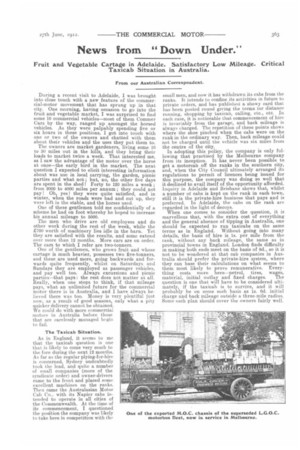News from "Down Under. 1 9
Page 13

If you've noticed an error in this article please click here to report it so we can fix it.
Fruit and Vegetable Cartage in Adelaide. Satisfactory Low Mileage. Critical Taxicab Situation in Australia.
From our Australian Correspondent.
During a recent visit to Adelaide, I was brought into close touch with a new feature of the commercial-motor movement that has sprung up in that city. One morning, having occasion to go into the fruit and vegetable market, I was surprised to find some 10 commercial vehicles—most of them Commer Cars by the way, ranged up amongst the horsed vehicles. As they were palpably spending five or six hours in these positions, I got into touch with one or two of the owners and chatted with them about their vehicles and the uses they put, them to. The owners are market gardeners, living some 10 to 30 miles out in the hills, and they bring their loads to market twice a week. That interested me, as I saw the advantage of the motor over the horse at once—the early bird in the market. The next question I expected to elicit interesting information about was use in local carrying, the garden, picnic parties and what not ; but, no, the other five days are spent in the shed! Forty to 120 miles a week ; from 2000 to 4000 miles per annum ; they could not pay! Oh, yes! they were quite satisfied, and in winter, when the roads were bad and cut up, they were left in the stable, and the horses used.
One of these gentlemen told me confidentially of a scheme he had on foot whereby he hoped to increase his annual mileage to 5000. The men who drive are old employees and do other work during the rest of the week, while the 2700 worth of machinery lies idle in the barn. Yet they are satisfied with the results, and some extend over more than 12 months. More cars are on order. The cars to which I refer are two-tonners.
One of the gentlemen, who grows fruit and whose cartage is much heavier, possesses two five-tonners, and these are used more, going backwards and forwards quite frequently, whilst on Saturdays and Sundays they are employed as passenger vehicles, and pay well too. Always excursions and picnic parties—that pays : the rest does not matter at all. Really, when one stops to think, if that mileage pays, what an unlimited future for the commercial motor there is in Australia, and I have always believed there was too. Money is very plentiful just now, as a result of good seasons, only what a pity quicker delivery cannot be obtained. We could do with more commercial motors in Australia before those that are carelessly managed begin to fail.
The Taxicab Situation.
As in England, it seems to me that the taxicab question is one that is likely to come very much to the fore during the next 12 months. As far as the regular plying-for-hire is concerned, Sydney undoubtedly took the lead, and quite a number of small companies (more of the syndicate order) and owner-drivers came to the front and placed some excellent machines on the ranks. Then came the Australasia,n Motor Cab Co.. with its Napier cabs intended to operate in all cities of the Commonwealth. At the time of its commencement, I questioned the position the company was likely to take here in competition with the small men, and now it has withdrawn its cabs from the ranks. It intends to confine its activities in future to private orders, and has published a showy card that has been posted round giving the terms tor distance running, shopping by taxicab, calling, etc., etc. In each case it is noticeable that commencement of hire is invariably from the garage, and back mileage is always charged. The repetition of these points shows where the shoe pinched when the cabs were on the rank in the ordinary way. Then, back mileage could not be charged until the vehicle was six miles from the centre of the city.
In adopting this policy, the company is only following that practised by the Melbourne company from its inception. It has never been possible to get a motorcab off the ranks in the southern city, and, when the City Council ultimately arranged its regulations to permit of licences being issued for this purpose, the company was doing so well that it declined to avail itself of the opportunity afforded. Inquiry in Adelaide and Brisbane shows that, whilst a number of cabs is kept on the rank in each town, still it is the private-hire business that pays and is preferred. In Adelaide, the cabs on the rank are regarded in the light of decoys. When one comes to consider the question, it is marvellous that, with the extra cost of everything and the general absence of tipping in Australia, one should be expected to run taxicabs on the same terms as in England. Without going into many details, the basis of hire is is. per mile from the rank, without any back mileage, the same as in provincial towns in England. London finds difficulty in making both ends meet on the basis of 8d., so it is not to be wondered at that cab companies in Australia should prefer the private-hire system, where they can base their calculations on what seems to them most likely to prove remunerative. Everything costs more here—petrol, tires, wages, material, initial outlay and fixed charges. The question is one that will have to be considered ultimately, if the taxicab is to survive, and it will probably be on some such basis as is. 6d. initial charge and back mileage outside a three-mile radius. Some such plan should cover the owners fairly well.






























